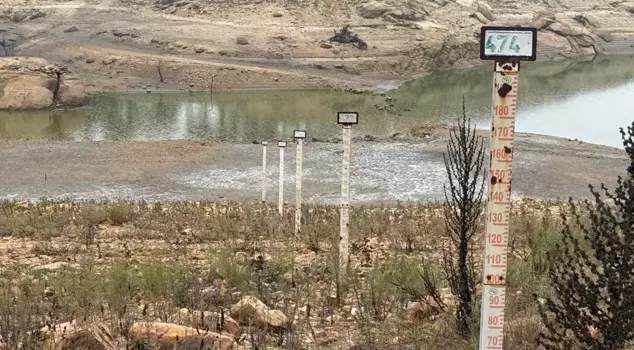
24.10.2025 14:28
In the Bodrum district of Muğla, the water level of the Geyik Dam, which provides drinking water, has decreased to 13%, while the water level of the Mumcular Dam is also at critical levels. Experts indicate that Bodrum's drinking water needs cannot be met within the next 10 days.
In the Bodrum district of Muğla, the water level in the Geyik Dam, which provides drinking and utility water, has dropped to 13% following the Mumcular Dam, which has reached its dead volume. Associate Professor Dr. Ceyhun Özçelik from Muğla Sıtkı Koçman University (MSKÜ) stated that if all of Bodrum's drinking water needs were to be met from the Geyik Dam, there would only be a 10-day water reserve left.
THE WATER SURFACE IS COVERED WITH GREEN ALGAE
Due to drought and decreased rainfall, the filling rates of the Geyik and Mumcular dams, which supply drinking water to Bodrum, have fallen to critical levels. The Mumcular Dam, which has a water capacity of 20 million cubic meters, has reached a filling level of 6%, which is at the dead volume level; the Geyik Dam, with a water capacity of 40 million cubic meters, is also facing the same danger. The filling rate in the Geyik Dam has also dropped to 13%. It has been observed that the water surface in the Geyik Dam is covered with lush green algae.
In a statement regarding the water stress experienced in Bodrum, Associate Professor Dr. Ceyhun Özçelik, Head of the Water Resources Department of the Civil Engineering Faculty at MSKÜ, said, "Bodrum's drinking water needs are around 1100 liters/second for an average of 500,000 people, of which 300 liters/second was supplied from the Mumcular Dam. When the Mumcular Dam dried up in recent months, this could not be obtained. From the Geyik Dam, 600 liters/second of water was being supplied. In recent weeks, due to drought, the 270 liters/second portion of this was cut off. As a result, the amount of water supplied from here has dropped to around 330 liters/second. The filling rate in the Geyik Dam is currently around 13%, which indicates that we have about 2 million cubic meters of water left until the dead volume. This corresponds to about 20 days of water if all of Bodrum's water needs were to be met from here. However, half of this water is used for thermal power plants. Therefore, it means we have a 10-day water reserve. The 300 liters/second from the Mumcular Dam and 270 liters/second from the Geyik Dam have been cut off. The remaining 330 liters/second will also be cut off after reaching the dead volume in the Geyik Dam. This means a total water cut of 900 liters/second from the Geyik and Mumcular dams," he stated.
'WE ARE EXPERIENCING THE DRIEST PERIOD IN 52 YEARS'
Dr. Özçelik stated in his remarks, "The current water usage shows that the city's water is supplied from the Akgedik Dam, which provides irrigation water to the Milas Plain, and from underground water wells. We are experiencing the driest period in the last 52 years. Although the drought rate in this region is slightly less than the national average, there is a water deficiency of about 25%. If the rainfall deficiency continues in the coming years, our underground water reserves will be at risk. As we deplete our own water, we are also increasingly stressing Milas's water. It is crucial to take necessary precautions and make plans for the future," he said.
Dr. Özçelik continued his remarks as follows:
"On the other hand, as the water level in the reservoirs decreases, the amount of oxygen in the dam lake also decreases. The decrease in oxygen levels increases the microbiological activities within the lake. The entire lake in the Geyik Dam has turned green due to algal blooms. In the coming days, as the water level decreases, the amount of sediment will also increase. There will be bursts in the transmission lines. While supplying water to the city, there will be a significant decrease in water quality. Monitoring the water level, using underground water levels without causing damage, and ensuring that the surrounding reservoirs are used in a controlled manner for future planning efforts are essential."